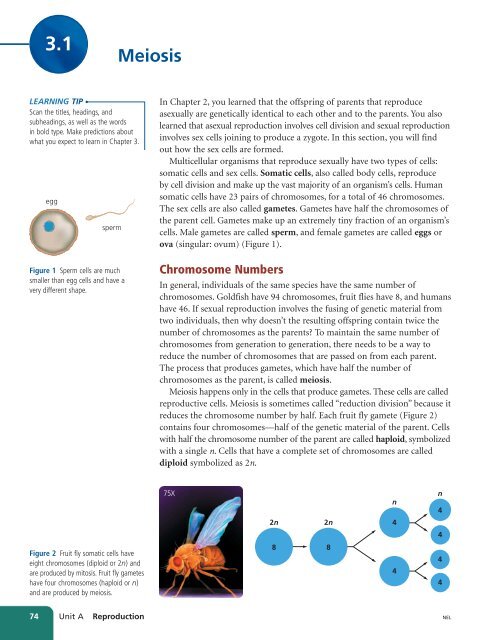Unit A Reproduction
Unit A Reproduction
Unit A Reproduction
You also want an ePaper? Increase the reach of your titles
YUMPU automatically turns print PDFs into web optimized ePapers that Google loves.
3.1<br />
Meiosis<br />
LEARNING TIP<br />
Scan the titles, headings, and<br />
subheadings, as well as the words<br />
in bold type. Make predictions about<br />
what you expect to learn in Chapter 3.<br />
egg<br />
sperm<br />
Figure 1 Sperm cells are much<br />
smaller than egg cells and have a<br />
very different shape.<br />
In Chapter 2, you learned that the offspring of parents that reproduce<br />
asexually are genetically identical to each other and to the parents. You also<br />
learned that asexual reproduction involves cell division and sexual reproduction<br />
involves sex cells joining to produce a zygote. In this section, you will find<br />
out how the sex cells are formed.<br />
Multicellular organisms that reproduce sexually have two types of cells:<br />
somatic cells and sex cells. Somatic cells, also called body cells, reproduce<br />
by cell division and make up the vast majority of an organism’s cells. Human<br />
somatic cells have 23 pairs of chromosomes, for a total of 46 chromosomes.<br />
The sex cells are also called gametes. Gametes have half the chromosomes of<br />
the parent cell. Gametes make up an extremely tiny fraction of an organism’s<br />
cells. Male gametes are called sperm, and female gametes are called eggs or<br />
ova (singular: ovum) (Figure 1).<br />
Chromosome Numbers<br />
In general, individuals of the same species have the same number of<br />
chromosomes. Goldfish have 94 chromosomes, fruit flies have 8, and humans<br />
have 46. If sexual reproduction involves the fusing of genetic material from<br />
two individuals, then why doesn’t the resulting offspring contain twice the<br />
number of chromosomes as the parents? To maintain the same number of<br />
chromosomes from generation to generation, there needs to be a way to<br />
reduce the number of chromosomes that are passed on from each parent.<br />
The process that produces gametes, which have half the number of<br />
chromosomes as the parent, is called meiosis.<br />
Meiosis happens only in the cells that produce gametes. These cells are called<br />
reproductive cells. Meiosis is sometimes called “reduction division” because it<br />
reduces the chromosome number by half. Each fruit fly gamete (Figure 2)<br />
contains four chromosomes—half of the genetic material of the parent. Cells<br />
with half the chromosome number of the parent are called haploid, symbolized<br />
with a single n. Cells that have a complete set of chromosomes are called<br />
diploid symbolized as 2n.<br />
75X<br />
n<br />
n<br />
4<br />
2n<br />
2n<br />
4<br />
4<br />
Figure 2 Fruit fly somatic cells have<br />
eight chromosomes (diploid or 2n) and<br />
are produced by mitosis. Fruit fly gametes<br />
have four chromosomes (haploid or n)<br />
and are produced by meiosis.<br />
8<br />
8<br />
4<br />
4<br />
4<br />
74 <strong>Unit</strong> A <strong>Reproduction</strong><br />
NEL

















